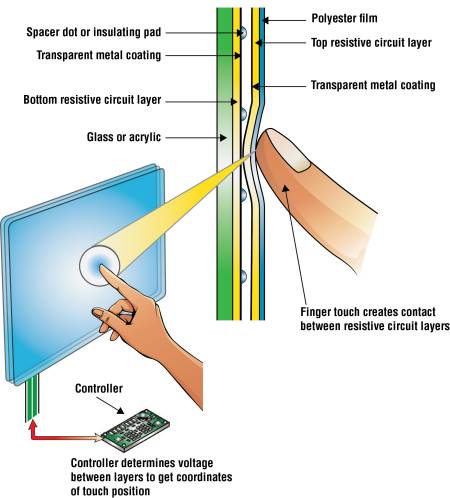Roll-to-roll printing a conductive metal ink offers an inexpensive, high performance alternative to today’s touchscreen technology.
A touchscreen is an essential feature of many modern devices, but the material that gives most screens their touch sensitivity is in short supply. By adapting newspaper printing technology, researchers at Agency for Science, Technology and Research (A*STAR), Singapore, have developed a low-cost alternative capable of printing conductive metal ink in lines so thin that they are invisible to the naked eye. A film of this fine metal mesh could potentially form the touch-sensing layer of future smartphone screens [1].
[pullquote]Industry has responded to the spike in indium prices accompanying the rising demand for ITO by intensifying the search for alternative transparent conductive materials.[/pullquote]
Most touchscreens rely on an electrically conductive material called indium tin oxide (ITO). As skin is conductive, touching the screen alters its electric field, which is detected as a tap. Crucially for a surface layer of a screen, ITO is also optically transparent. Very few materials possess this combination of properties. Industry has responded to the spike in indium prices accompanying the rising demand for ITO by intensifying the search for alternative transparent conductive materials.
XinQuan Zhang from the Singapore Institute of Manufacturing Technology and his co-workers are working on a promising alternative touch-sensitive film: a printed, mesh-like pattern of ultra-fine metal lines, created using roll-to-roll gravure printing. Gravure printing traditionally uses an etched mold to transfer ink on to paper. Here, the etched cylindrical mold instead transfers a precise pattern of conductive metal ink on to the touch-sensing substrate.
Light from the screen passes through the holes in the printed mesh. Before this study, the finest lines that could be printed this way were approximately 50 micrometers wide, which blocked more than a third of the screen’s light. Zhang and his co-workers have overcome this limitation through diamond micro engraving. Instead of using a laser to etch the grid-like pattern of tiny inkwells into the printer’s cylindrical mold, Zhang uses a tiny diamond-tipped cutting tool to pattern the roller using ultraprecision machining technology.
Zhang and his co-workers have overcome this limitation through diamond micro engraving. Instead of using a laser to etch the grid-like pattern of tiny inkwells into the printer’s cylindrical mold, Zhang uses a tiny diamond-tipped cutting tool to pattern the roller using ultraprecision machining technology.
Originally developed to manufacture lenses and optical components, “ultraprecision machining has never been used for gravure printing,” Zhang says. His team successfully adapted the machine to cut tiny inkwells on the roller, two and a half times smaller than a laser could etch. Using this roller, the team printed a mesh of metal lines just 19 micrometers across. More than 80 per cent of visible light passed through this mesh, matching ITO’s optical performance.
Although ultraprecision machining can produce very finely patterned rollers, the process is slow, says Zhang. “This is one disadvantage compared to lasers,” he says. Next the team will “improve the process of ultraprecision machining to make it faster, so the roller mold will be affordable to industry.”
The A*STAR-affiliated researchers contributing to this research are from the Singapore Institute of Manufacturing Technology









